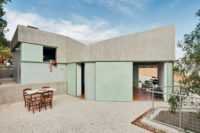The economy is having a devastating effect on architectural talent.
 |
| PHOTOGRAPHY: © Antonio Rull |
| Sparked by the crumbling economy, peaceful protests began taking place in Spain, such as one on May 19, 2011, at the Plaza de la Encarnación in Seville. The Metropol Parasol designed by J. Mayer H. Architects framed the occasion. |
Can Spain's architects survive the nation's deepening economic downturn, now in its fourth year? Over the last several decades the country had gained international renown for the quality and innovation of its architecture, designed by both local and international figures. The exhibition "On-Site: New Architecture in Spain" at New York's Museum of Modern Art in 2006 attested to its accomplishments.
But the collapse of the speculative building bubble, with housing starts dropping from 920,000 in 2006 to 60,000 last year, triggered an implosion of public works, bringing the entire construction sector—and architectural commissions with it—to a standstill.
Various sources estimate that more than 45 percent of Spain's architecture studios have closed since the start of the crisis, and many others remain open in name only. Surviving firms have shed staff and cut expenses. The 11 partners of Associated Architects, Engineers & Urban Planners (AUIA), specialists in social housing and urban planning for over 40 years, have dismissed their entire staff of 40, rehiring them on temporary contracts as needed. Revenues are only 10 to 15 percent of those during the boom, says partner Manuel Paredes. But his former staff receives unemployment benefits, he notes, unlike those in some firms that skirt the law.
Rafael de La-Hoz, who heads his own firm in Madrid, says he has cut staff 50 percent over the past four years, and his billings have fallen 30 percent. Most discharged architects, says La-Hoz, are collecting unemployment, going after master's degrees, or teaching. Some have returned to their countries of origin, while others, he notes, have found work abroad, mainly in London and Germany.
Small firms, which dominate the profession, face a more dramatic situation, particularly those architects who got their start in open competitions for public works during the boom years. Clara Eslava and Miguel Tejada, married and in their forties, got their first break in the 2004 competition to redesign Calle Serrano, Madrid's Madison Avenue, which they finished last year. Now Eslava says she feels part of “a lost generation.” Like many colleagues, she is working on a Ph.D. thesis and seeking teaching posts.
Iciar de las Casas, in her early forties, is also working on a Ph.D., as well as developing a product in conjunction with a manufacturer and a university. “I spend many sleepless nights planning new ventures,” de las Casas confesses. She has eliminated staff and moved her studio into her home.
Meanwhile her brother and partner, Sergio de las Casas, has applied for a visa to move his family to Perth, Australia. He joins a diaspora of talent estimated at 4,000 of Spain's 60,000 licensed architects, according to an informal poll conducted by the Sindicato de Arquitectos de España. Of those surveyed, 65 percent said that they would “be willing to consider” moving abroad. Young architects lead the exodus to other European countries, where their licenses are recognized, or farther afield to, say, South America, Qatar, or China. Sometimes they can double their salaries. José Antonio Granero, president of the Colegio de Arquitectos de Madrid (COAM), the city's professional association, comments that Spanish professionals are highly valued abroad for their “technical and humanistic training.”
Many architects lacked work and high pay even in good times, owing to an oversupply. Spain produces 3,000 architectural graduates a year, and has one licensed architect per 800 inhabitants, compared with one per 1,500 in the rest of Europe. Granero maintains that an architecture degree prepares students for many different fields (e.g., graphic design, energy conservation), although the Sindicato survey found only 14 percent of the architects who responded worked in other specialties.
To change the situation for the better, Granero proposes redirecting private development from new construction to renovation. COAM is working on legislative proposals to ease this change. “Spain has 6 million housing units more than 50 years old,” he points out. “Renovating them can attract foreign investment.”
Individual architects are coming up with other alternatives. The Madrid firm Ecosistema Urbano recently won a competition to revitalize a Barcelona shopping center with falling revenues. Instead of the face-lift proposed by the owners, partners Belinda Tato and José Luis Vallejo suggested dedicating empty storefronts to community activities, converting the mall into an urban center.
Working in Vallejo and Tato's studio are several activists in Madrid's 15-M movement, named after the peaceful protests of May 2011 that the Spanish claim inspired Occupy Wall Street. Social activism has spread to older architects in Madrid's comfortable northern suburbs. Landscape architect Beatriz Lombao, her associate Marta Torres, and Lombao's husband, the architect Javier Maroto, converted a neglected estate into an organic vegetable garden, with chickens and geese, a crafts fair, and a shaded hangout for food and drink. This back-to-the-earth movement, familiar to certain Americans, was previously unheard of here. “It's not an intellectual project,” Maroto says, “but activism based on people relating to one another, and sharing a different way of living.”
RECORD


Post a comment to this article
Report Abusive Comment